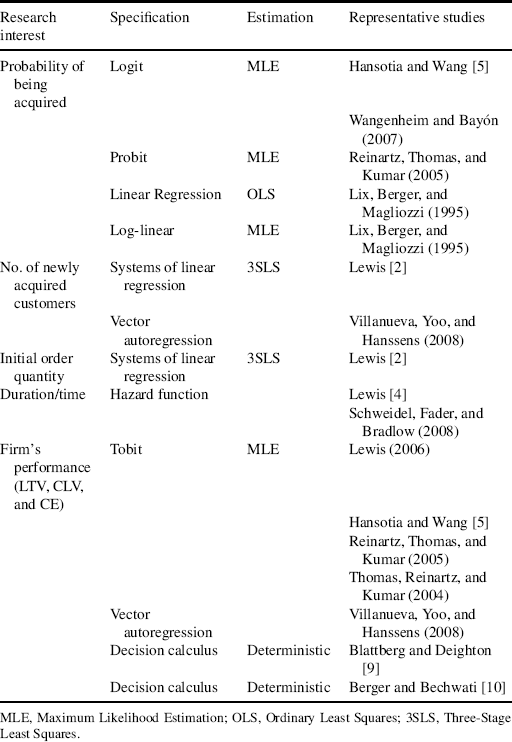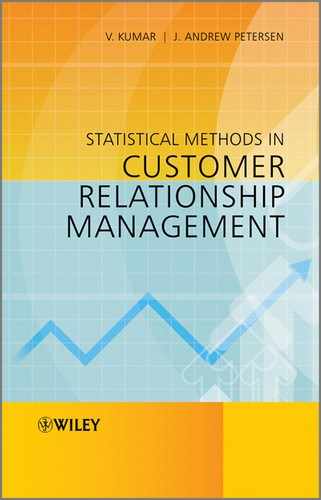3.1 Introduction
As many companies have transited from brand-centric to customer-centric, the management of customer relationships has become especially important. Much research attention has also transferred from the product life cycle to the customer life cycle. Along the customer life cycle, the essential processes of CRM can be separated into four circulatory steps: customer acquisition, customer retention, customer churn, and customer win-back. Customer acquisition, the first step, is the foundation of the whole CRM process and is also a cornerstone in the development of the business of a company. The statement that acquiring a new customer is several times more costly than retaining an existing customer has clearly shown the importance of a successful customer acquisition program. And, without sustained customer acquisition there will eventually be no customers left for the company to try and retain. Despite the significance of customer acquisition, research on this topic is still not sufficient. This chapter seeks to review and summarize the limited research on customer acquisition and provide guidelines on how a firm can use its own prospect and customer data to aid in successful and profitable customer acquisition.
In the past 15 years, researchers have paid attention to the key issues which occur in the customer acquisition process. Questions that have been considered, as shown in Figure 3.1, include:
- How likely is it that the prospects will respond to our acquisition promotion?
- How many new customers can we acquire in this campaign?
- How many orders will each of our newly acquired customers place?
- How do the marketing variables, such as shipping fee, word-of-mouth referral, and promotion depth, influence prospects' response behavior?
- How long will the newly acquired customers stay with our companies?
- How much profit or value will this acquisition campaign bring to our companies?
Figure 3.1 Issues addressed in customer acquisition models (LTV, Lifetime Value; CE, Customer Equity).

Many studies have been conducted and many models have been developed to try and solve these questions. Table 3.1 lists a representative set of studies that have considered these issues and accounted for many of the problems that might occur in the model-building process. To provide a comprehensive understanding of how to model customer acquisition, we will review the issues in the studies one by one along with the related modeling techniques (Table 3.2). We will also provide empirical examples at the end of each subsection to demonstrate how to apply this knowledge to a representative sample of customers from a B2B firm.
Table 3.1 Summary of select empirical studies modeling customer acquisition.


Table 3.2 Review of customer acquisition models.

Due to the differences in how the data can be collected and modeled, the first question that often needs to be answered is whether the company has customers that purchase in a non-contractual or contractual manner. In many instances this will determine the type of statistical model that needs to be used in order to gain any insights from the data.
In non-contractual business settings, such as for retailing firms and catalog companies, customers can freely split their spending across several firms and make purchases from these firms either occasionally/irregularly or frequently/regularly. The key difference from a modeling perspective is that in all non-contractual situations, the firm never actually observes when a customer is no longer a customer. Thus, once the customers make the first purchase from the company, it is uncertain how often they will buy again and for how long they will repeat-purchase from that company. Thus, companies in non-contractual business settings need to consider the probability that new customers will be attracted to buy the first time, how many orders they will bring to the companies over time, and how much profit they will generate over their lifetimes.
In contractual business settings, such as newspaper subscriptions and telecommunications services, customers usually pay their subscription or service fees monthly or yearly and companies know when customers leave the relationship. Once the customers are acquired to join the membership or sign a contract, companies have a guarantee of continuous future cash flow for a period of time. Thus, companies in contractual business settings are concerned most with the expected duration or time of the relationship with customers, mainly because the duration of the relationship is often a key driver of future customer profitability. The key difference here from a modeling perspective is that in all contractual situations, the firm does observe when a customer is no longer a customer since the regular cash flows end. Because of the unique characteristics of non-contractual and contractual business settings, researchers need to build different models to study the issues in customer acquisition in contractual versus non-contractual settings.
We will provide additional discussion in each section where the contractual nature of the situation drives the model selection decision.
3.1.1 Data for Empirical Examples
In this chapter we will be providing a description of the key modeling frameworks that attempt to answer each key research question raised at the beginning of the chapter. We will also be providing at least one empirical example at the end of each subsection which will show how sample data can be used to answer these key research questions. For all the empirical examples in this chapter we provide a dataset titled ‘Customer Acquisition.’ In this dataset you will find a representative sample of 500 prospects from a typical B2B firm. The data include the following variables which will be used in some combination for each of the subsequent analyses:
| Variable | |
| Customer | Customer number (from 1 to 500) |
| Acquisition | 1 if the prospect was acquired, 0 otherwise |
| First_Purchase | Dollar value of the first purchase (0 if the customer was not acquired) |
| CLV | The predicted customer lifetime value score. It is 0 if the prospect was not acquired or has already churned from the firm (000s) |
| Duration | The time in days that the acquired prospect has been or was a customer, right-censored at 730 d |
| Censor | 1 if the customer was still a customer at the end of the observation window, 0 otherwise |
| Acq_Expense | Dollars spent on marketing efforts to try and acquire that prospect |
| Acq_Expense_SQ | Square of dollars spent on marketing efforts to try and acquire that prospect |
| Industry | 1 if the prospect is in the B2B industry, 0 otherwise |
| Revenue | Annual sales revenue of the prospect's firm (in millions of dollars) |
| Employees | Number of employees in the prospect's firm |
| Ret_Expense | Dollars spent on marketing efforts to try and retain that customer |
| Ret_Expense_SQ | Square of dollars spent on marketing efforts to try and retain that customer |
| Crossbuy | The number of categories the customer has purchased |
| Frequency | The number of times the customer purchased during the observation window |
| Frequency_SQ | The square of the number of times the customer purchased during the observation window |
These data will be used for each of the examples presented at the end of each of the sections. These examples will cover the topics of response probability, number of newly acquired customers, initial order quantity, duration/time, and firm's performance.
